Integrating Sustainability Assessment into Decoupling Analysis: A Focus on the Yangtze River Delta Urban Agglomerations
Abstract
:1. Introduction
2. Materials and Methods
2.1. Study Area
2.2. Environmental Sustainability Assessment
2.2.1. Measuring Environmental Footprints
2.2.2. Measuring Environmental Boundaries
2.3. Urbanization Monitoring
2.4. Decoupling Analysis
2.5. Data
3. Results
3.1. Environmental Sustainability Assessment
3.2. Decoupling Analysis
3.3. Classification of the Cities
4. Discussion
4.1. Revisiting Decoupling Analysis from a Sustainability Perspective
4.2. Limitations and Potential Solutions
4.3. Policy Implications
5. Conclusions
Author Contributions
Funding
Conflicts of Interest
References
- National Bureau of Statistics of the People’s Republic of China. Available online: http://data.stats.gov.cn/easyquery.htm?cn=C01&zb=A0305&sj=2019 (accessed on 13 August 2020).
- Bai, X.; McPhearson, T.; Cleugh, H.; Nagendra, H.; Tong, X.; Zhu, T.; Zhu, Y. Linking Urbanization and the Environment: Conceptual and Empirical Advances. Annu. Rev. Environ. Resour. 2017, 42, 215–240. [Google Scholar] [CrossRef] [Green Version]
- Yu, S.; Yu, G.B.; Liu, Y.; Li, G.; Feng, S.; Wu, S.C.; Wong, M.H. Urbanization impairs surface water quality: Eutrophication and metal stress in the grand canal of China. River Res. Appl. 2011, 28, 1135–1148. [Google Scholar] [CrossRef]
- He, C.; Zhou, L.; Ma, W.; Wang, Y. Spatial Assessment of Urban Climate Change Vulnerability during Different Urbanization Phases. Sustainability 2019, 11, 2406. [Google Scholar] [CrossRef] [Green Version]
- Silver, B.; Reddington, C.L.; Arnold, S.R.; Spracklen, D.V. Substantial changes in air pollution across China during 2015–2017. Environ. Res. Lett. 2018, 13, 114012. [Google Scholar] [CrossRef]
- Li, W.; Hai, X.; Han, L.; Mao, J.; Tian, M. Does urbanization intensify regional water scarcity? Evidence and implications from a megaregion of China. J. Clean. Prod. 2020, 244, 118592. [Google Scholar] [CrossRef]
- Fang, K.; Wang, T.; He, J.; Wang, T.; Xie, X.; Tang, Y.; Shen, Y.; Xu, A. The distribution and drivers of PM2.5 in a rapidly urbanizing region: The Belt and Road Initiative in focus. Sci. Total Environ. 2020, 716, 137010. [Google Scholar] [CrossRef]
- Sun, Y.; Zhang, X.; Ren, G.; Zwiers, F.W.; Hu, T. Contribution of urbanization to warming in China. Nat. Clim. Chang. 2016, 6, 706–709. [Google Scholar] [CrossRef]
- Song, Y.; Zhang, M.; Zhou, M. Study on the decoupling relationship between CO2 emissions and economic development based on two-dimensional decoupling theory: A case between China and the United States. Ecol. Indic. 2019, 102, 230–236. [Google Scholar] [CrossRef]
- Sarkodie, S.A.; Strezov, V. A review on Environmental Kuznets Curve hypothesis using bibliometric and meta-analysis. Sci. Total Environ. 2019, 649, 128–145. [Google Scholar] [CrossRef]
- Marques, A.C.; Fuinhas, J.A.; Leal, P. The impact of economic growth on CO2 emissions in Australia: The environmental Kuznets curve and the decoupling index. Environ. Sci. Pollut. Res. 2018, 25, 27283–27296. [Google Scholar] [CrossRef]
- Hao, Y.; Huang, Z.; Wu, H. Do Carbon Emissions and Economic Growth Decouple in China? An Empirical Analysis Based on Provincial Panel Data. Energies 2019, 12, 2411. [Google Scholar] [CrossRef] [Green Version]
- Lin, B.; Omoju, O.E.; Nwakeze, N.M.; Okonkwo, J.U.; Megbowon, E.T. Is the environmental Kuznets curve hypothesis a sound basis for environmental policy in Africa? J. Clean. Prod. 2016, 133, 712–724. [Google Scholar] [CrossRef]
- Jaligot, R.; Chenal, J. Decoupling municipal solid waste generation and economic growth in the canton of Vaud, Switzerland. Resour. Conserv. Recycl. 2018, 130, 260–266. [Google Scholar] [CrossRef]
- Fischer-Kowalski, M.; von Weizsacker, E.U.; Ren, Y.; Moriguchi, Y.; Crane, W.; Krausmann, F.; Eisenmenger, N.; Giljum, S.; Hennicke, P.; Kemp, R.; et al. Decoupling Natural Resource Use and Environmental Impacts from Economic Growth; International Resource Panel, Ed.; United Nations Environment Programme: Nairobi, Kenya, 2011; pp. 1–54. [Google Scholar]
- Schandl, H.; Hatfield-Dodds, S.; Wiedmann, T.; Geschke, A.; Cai, Y.; West, J.; Newth, D.; Baynes, T.; Lenzen, M.; Owen, A. Decoupling global environmental pressure and economic growth: Scenarios for energy use, materials use and carbon emissions. J. Clean. Prod. 2016, 132, 45–56. [Google Scholar] [CrossRef]
- Pao, H.-T.; Chen, C.-C. Decoupling strategies: CO2 emissions, energy resources, and economic growth in the Group of Twenty. J. Clean. Prod. 2019, 206, 907–919. [Google Scholar] [CrossRef]
- Grand, M.C. Carbon emission targets and decoupling indicators. Ecol. Indic. 2016, 67, 649–656. [Google Scholar] [CrossRef]
- Ruffing, K. Indicators to measure decoupling of environmental pressure from economic growth. In Sustainability Indicators: A Scientific Assessment; Hák, T., Moldan, B., Dahl, A.L., Eds.; Island Press: Washington, DC, USA, 2007; pp. 211–222. [Google Scholar]
- Tapio, P. Towards a theory of decoupling: Degrees of decoupling in the EU and the case of road traffic in Finland between 1970 and 2001. Transp. Policy 2005, 12, 137–151. [Google Scholar] [CrossRef] [Green Version]
- Cohen, G.; Jalles, J.T.; Loungani, P.; Marto, R. The long-run decoupling of emissions and output: Evidence from the largest emitters. Energy Policy 2018, 118, 58–68. [Google Scholar] [CrossRef]
- Shuai, C.; Chen, X.; Wu, Y.; Zhang, Y.; Tan, Y. A three-step strategy for decoupling economic growth from carbon emission: Empirical evidences from 133 countries. Sci. Total Environ. 2018, 646, 524–543. [Google Scholar] [CrossRef]
- Moreau, V.; Vuille, F. Decoupling energy use and economic growth: Counter evidence from structural effects and embodied energy in trade. Appl. Energy 2018, 215, 54–62. [Google Scholar] [CrossRef]
- Wu, Y.; Zhu, Q.; Zhu, B. Comparisons of decoupling trends of global economic growth and energy consumption between developed and developing countries. Energy Policy 2018, 116, 30–38. [Google Scholar] [CrossRef]
- Wang, Q.; Zhao, M.; Li, R.; Su, M. Decomposition and decoupling analysis of carbon emissions from economic growth: A comparative study of China and the United States. J. Clean. Prod. 2018, 197, 178–184. [Google Scholar] [CrossRef]
- Zhang, X.; Geng, Y.; Shao, S.; Song, X.; Fan, M.; Yang, L.; Song, J. Decoupling PM2.5 emissions and economic growth in China over 1998–2016: A regional investment perspective. Sci. Total Environ. 2020, 714, 136841. [Google Scholar] [CrossRef]
- Wang, Q.; Wang, X. Moving to economic growth without water demand growth—A decomposition analysis of decoupling from economic growth and water use in 31 provinces of China. Sci. Total Environ. 2020, 726, 138362. [Google Scholar] [CrossRef]
- Szigeti, C.; Toth, G.; Szabo, D.R. Decoupling—Shifts in ecological footprint intensity of nations in the last decade. Ecol. Indic. 2017, 72, 111–117. [Google Scholar] [CrossRef]
- Fan, W.; Meng, M.; Lu, J.; Dong, X.; Fan, W.; Wang, X.; Zhang, Q. Decoupling Elasticity and Driving Factors of Energy Consumption and Economic Development in the Qinghai-Tibet Plateau. Sustainability 2020, 12, 1326. [Google Scholar] [CrossRef] [Green Version]
- Yu, Y.; Chen, D.; Zhu, B.; Hu, S. Eco-efficiency trends in China, 1978–2010: Decoupling environmental pressure from economic growth. Ecol. Indic. 2013, 24, 177–184. [Google Scholar] [CrossRef]
- Hatfield-Dodds, S.; Schandl, H.; Adams, P.D.; Baynes, T.; Brinsmead, T.S.; Bryan, B.A.; Chiew, F.H.S.; Graham, P.; Grundy, M.; Harwood, T.; et al. Australia is ‘free to choose’ economic growth and falling environmental pressures. Nature 2015, 527, 49–53. [Google Scholar] [CrossRef]
- Bithas, K.; Kalimeris, P. Unmasking decoupling: Redefining the Resource Intensity of the Economy. Sci. Total Environ. 2018, 619, 338–351. [Google Scholar] [CrossRef]
- Akizu-Gardoki, O.; Bueno, G.; Wiedmann, T.; Lopez-Guede, J.M.; Arto, I.; Hernandez, P.; Moran, D. Decoupling between human development and energy consumption within footprint accounts. J. Clean. Prod. 2018, 202, 1145–1157. [Google Scholar] [CrossRef]
- Cibulka, S.; Giljum, S. Towards a Comprehensive Framework of the Relationships between Resource Footprints, Quality of Life, and Economic Development. Sustainability 2020, 12, 4734. [Google Scholar] [CrossRef]
- Yang, Y.; Liu, Y.; Li, Y.; Li, J. Measure of urban-rural transformation in Beijing-Tianjin-Hebei region in the new millennium: Population-land-industry perspective. Land Use Policy 2018, 79, 595–608. [Google Scholar] [CrossRef]
- Liang, W.; Yang, M. Urbanization, economic growth and environmental pollution: Evidence from China. Sustain. Comput. Inform. Syst. 2019, 21, 1–9. [Google Scholar] [CrossRef]
- Bao, C.; Zou, J. Exploring the Coupling and Decoupling Relationships between Urbanization Quality and Water Resources Constraint Intensity: Spatiotemporal Analysis for Northwest China. Sustainability 2017, 9, 1960. [Google Scholar] [CrossRef] [Green Version]
- Wang, T.; Riti, J.S.; Shu, Y. Decoupling emissions of greenhouse gas, urbanization, energy and income: Analysis from the economy of China. Environ. Sci. Pollut. Res. 2018, 25, 19845–19858. [Google Scholar] [CrossRef]
- Ariken, M.; Zhang, F.; Liu, K.; Fang, C.; Kung, H.-T. Coupling coordination analysis of urbanization and eco-environment in Yanqi Basin based on multi-source remote sensing data. Ecol. Indic. 2020, 114, 106331. [Google Scholar] [CrossRef]
- Wang, Z.; Liang, L.; Sun, Z.; Wang, X. Spatiotemporal differentiation and the factors influencing urbanization and ecological environment synergistic effects within the Beijing-Tianjin-Hebei urban agglomeration. J. Environ. Manag. 2019, 243, 227–239. [Google Scholar] [CrossRef]
- Wang, J.; Wang, S.; Li, S.; Feng, K. Coupling analysis of urbanization and energy-environment efficiency: Evidence from Guangdong province. Appl. Energy 2019, 254, 113650. [Google Scholar] [CrossRef]
- Moldan, B.; Janoušková, S.; Hak, T. How to understand and measure environmental sustainability: Indicators and targets. Ecol. Indic. 2012, 17, 4–13. [Google Scholar] [CrossRef]
- Fang, K.; Heijungs, R.; De Snoo, G.R. Understanding the complementary linkages between environmental footprints and planetary boundaries in a footprint–boundary environmental sustainability assessment framework. Ecol. Econ. 2015, 114, 218–226. [Google Scholar] [CrossRef]
- Ekins, P. Environmental sustainability: From environmental valuation to the sustainability gap. Prog. Phys. Geogr. 2011, 35, 629–651. [Google Scholar] [CrossRef]
- Hoekstra, A.Y.; Wiedmann, T. Humanity’s unsustainable environmental footprint. Science 2014, 344, 1114–1117. [Google Scholar] [CrossRef]
- Galli, A.; Wiedmann, T.; Ercin, A.E.; Knoblauch, D.; Ewing, B.; Giljum, S. Integrating Ecological, Carbon and Water footprint into a “Footprint Family” of indicators: Definition and role in tracking human pressure on the planet. Ecol. Indic. 2012, 16, 100–112. [Google Scholar] [CrossRef]
- Fang, K.; Heijungs, R.; De Snoo, G.R. Theoretical exploration for the combination of the ecological, energy, carbon, and water footprints: Overview of a footprint family. Ecol. Indic. 2014, 36, 508–518. [Google Scholar] [CrossRef]
- Lin, D.; Hanscom, L.; Murthy, A.; Galli, A.; Evans, M.; Neill, E.; Mancini, M.S.; Martindill, J.; Medouar, F.-Z.; Huang, S.; et al. Ecological Footprint Accounting for Countries: Updates and Results of the National Footprint Accounts, 2012–2018. Resources 2018, 7, 58. [Google Scholar] [CrossRef] [Green Version]
- Wiedmann, T.; Minx, J. A definition of ‘carbon footprint’. Ecol. Econ. Res. Trends 2008, 1, 1–11. [Google Scholar]
- Hoekstra, A.Y.; Mekonnen, M.M. The water footprint of humanity. Proc. Natl. Acad. Sci. USA 2012, 109, 3232–3237. [Google Scholar] [CrossRef] [Green Version]
- Leach, A.M.; Galloway, J.N.; Bleeker, A.; Erisman, J.W.; Kohn, R.; Kitzes, J. A nitrogen footprint model to help consumers understand their role in nitrogen losses to the environment. Environ. Dev. 2012, 1, 40–66. [Google Scholar] [CrossRef] [Green Version]
- Li, M.; Wiedmann, T.; Hadjikakou, M. Towards meaningful consumption-based planetary boundary indicators: The phosphorus exceedance footprint. Glob. Environ. Chang. 2019, 54, 227–238. [Google Scholar] [CrossRef]
- Yang, S.; Chen, B.; Wakeel, M.; Hayat, T.; Alsaedi, A.; Ahmad, B. PM2.5 footprint of household energy consumption. Appl. Energy 2018, 227, 375–383. [Google Scholar] [CrossRef]
- Rockström, J.; Steffen, W.; Noone, K.; Persson, Å.; Chapin, F.S.; Lambin, E.F.; Lenton, T.M.; Scheffer, M.; Folke, C.; Schellnhuber, H.J.; et al. A safe operating space for humanity. Nature 2009, 461, 472–475. [Google Scholar] [CrossRef]
- Shao, S.; Chen, Y.; Li, K.; Yang, L. Market segmentation and urban CO2 emissions in China: Evidence from the Yangtze River Delta region. J. Environ. Manag. 2019, 248, 109324. [Google Scholar] [CrossRef]
- National Development and Reform Commission of the People’s Republic of China. Available online: https://www.ndrc.gov.cn/xxgk/zcfb/ghwb/201606/t20160603_962187.html (accessed on 13 August 2020).
- Fang, K.; Heijungs, R.; Duan, Z.; De Snoo, G.R. The Environmental Sustainability of Nations: Benchmarking the Carbon, Water and Land Footprints against Allocated Planetary Boundaries. Sustainanility 2015, 7, 11285–11305. [Google Scholar] [CrossRef] [Green Version]
- 2006 IPCC Guidelines for National Greenhouse Gas Inventories. Available online: https://www.ipcc.ch/report/2006-ipcc-guidelines-for-national-greenhouse-gas-inventories/ (accessed on 16 August 2020).
- Goldberg, M.H.; Van Der Linden, S.; Maibach, E.; Leiserowitz, A. Discussing global warming leads to greater acceptance of climate science. Proc. Natl. Acad. Sci. USA 2019, 116, 14804–14805. [Google Scholar] [CrossRef] [Green Version]
- Chakrabarti, S. Eutrophication—A global aquatic environmental problem: A review. Res. Rev. J. Ecol. Environ. Sci. 2018, 6, 1–6. [Google Scholar]
- Lucas, P.L.; Wilting, H.C.; Hof, A.F.; Van Vuuren, D.P. Allocating planetary boundaries to large economies: Distributional consequences of alternative perspectives on distributive fairness. Glob. Environ. Chang. 2020, 60, 102017. [Google Scholar] [CrossRef]
- Hjalsted, A.W.; Laurent, A.; Andersen, M.M.; Olsen, K.H.; Ryberg, M.; Hauschild, M. Sharing the safe operating space: Exploring ethical allocation principles to operationalize the planetary boundaries and assess absolute sustainability at individual and industrial sector levels. J. Ind. Ecol. 2020, 1–14. [Google Scholar] [CrossRef]
- Ministry of Ecology and Environment of the People’s Republic of China. Available online: http://www.mee.gov.cn/xxgk2018/xxgk/xxgk15/201808/t20180815_630438.html (accessed on 28 June 2020).
- Van Donkelaar, A.; Martin, R.V.; Brauer, M.; Hsu, N.C.; Kahn, R.A.; Levy, R.C.; Lyapustin, A.; Sayer, A.M.; Winker, D.M. Global Estimates of Fine Particulate Matter using a Combined Geophysical-Statistical Method with Information from Satellites, Models, and Monitors. Environ. Sci. Technol. 2016, 50, 3762–3772. [Google Scholar] [CrossRef]
- Liu, M.; Li, W. Calculation of equivalence factor used in ecological footprint for China and its provinces based on net primary production. J. Ecol. Rural Environ. 2010, 26, 401–406. (In Chinese) [Google Scholar]
- Xie, H.; Ye, H. The update computation for global average yield of main agricultural products in China. J. Guangzhou Univ. (Nat. Sci. Ed.) 2008, 7, 76–80. (In Chinese) [Google Scholar]
- Kahrl, F.; Li, Y.; Su, Y.; Tennigkeit, T.; Wilkes, A.; Xu, J. Greenhouse gas emissions from nitrogen fertilizer use in China. Environ. Sci. Policy 2010, 13, 688–694. [Google Scholar] [CrossRef]
- Wu, H.; Wang, S.; Gao, L.; Zhang, L.; Yuan, Z.; Fan, T.; Wei, K.; Huang, L. Nutrient-derived environmental impacts in Chinese agriculture during 1978–2015. J. Environ. Manag. 2018, 217, 762–774. [Google Scholar] [CrossRef]
- O’Neill, D.W.; Fanning, A.L.; Lamb, W.F.; Steinberger, J.K. A good life for all within planetary boundaries. Nat. Sustain. 2018, 1, 88–95. [Google Scholar] [CrossRef] [Green Version]
- Liu, M.; Li, W.; Xie, G. Estimation of China ecological footprint production coefficient based on net primary productivity. Chin. J. Ecol. 2010, 29, 592–597. (In Chinese) [Google Scholar]
- Hachaichi, M.; Baouni, T. Downscaling the planetary boundaries (Pbs) framework to city scale-level: De-risking MENA region’s environment future. Environ. Sustain. Indic. 2020, 5, 100023. [Google Scholar] [CrossRef]
- Hertwich, E.; Gibon, T.; Bouman, E.A.; Arvesen, A.; Suh, S.; Heath, G.A.; Bergesen, J.D.; Ramírez, A.; Vega, M.I.; Shi, L. Integrated life-cycle assessment of electricity-supply scenarios confirms global environmental benefit of low-carbon technologies. Proc. Natl. Acad. Sci. USA 2014, 112, 6277–6282. [Google Scholar] [CrossRef] [Green Version]
- Bai, Y.; Wong, C.P.; Jiang, B.; Hughes, A.C.; Wang, M.; Wang, Q. Developing China’s Ecological Redline Policy using ecosystem services assessments for land use planning. Nat. Commun. 2018, 9, 3034. [Google Scholar] [CrossRef] [Green Version]
- Yu, J.; Zhou, K.; Yang, S. Land use efficiency and influencing factors of urban agglomerations in China. Land Use Policy 2019, 88, 104143. [Google Scholar] [CrossRef]
- Li, Y.; Chang, M.; Ding, S.; Wang, S.; Ni, D.; Hu, H. Monitoring and source apportionment of trace elements in PM 2.5: Implications for local air quality management. J. Environ. Manag. 2017, 196, 16–25. [Google Scholar] [CrossRef]
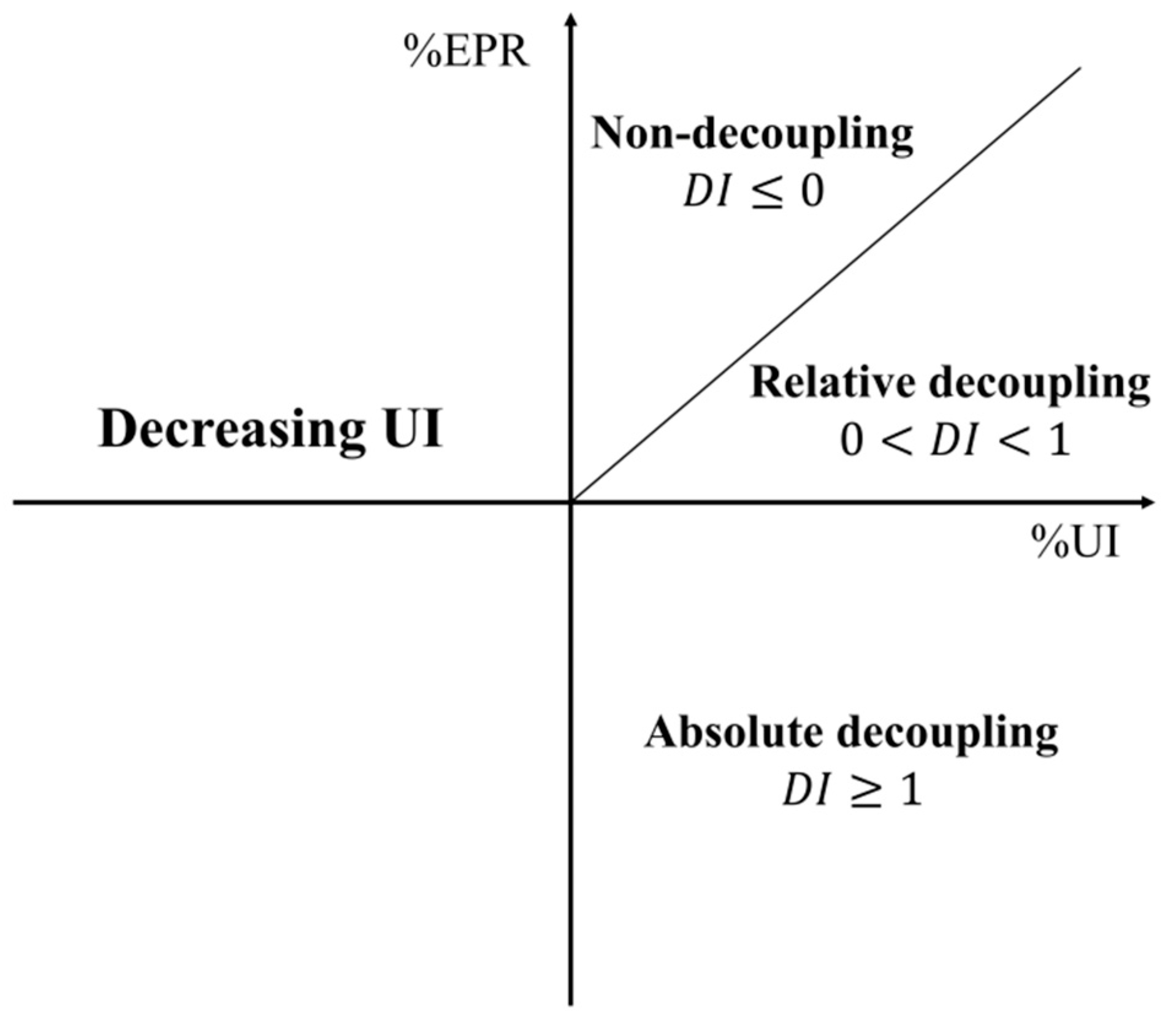
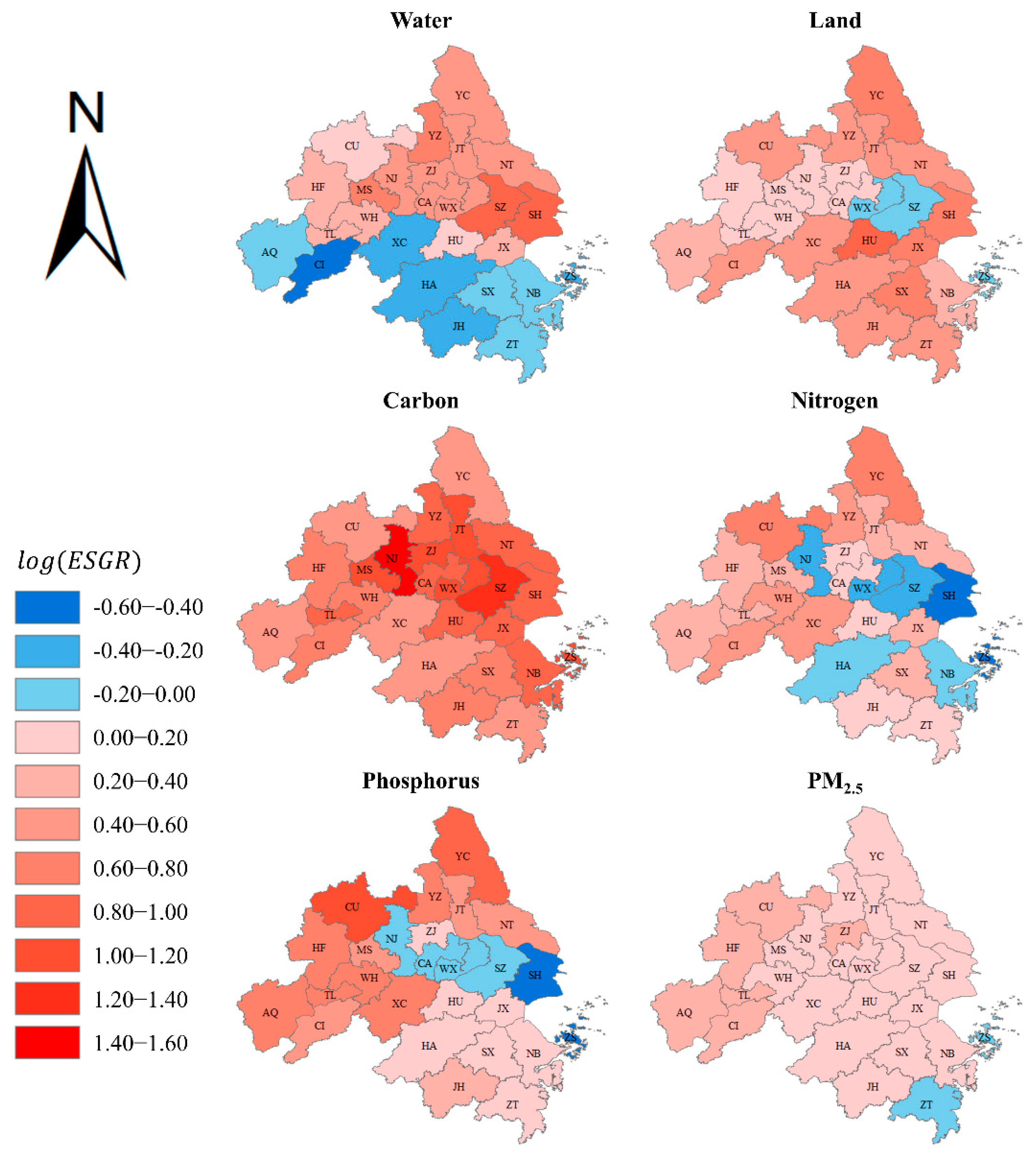
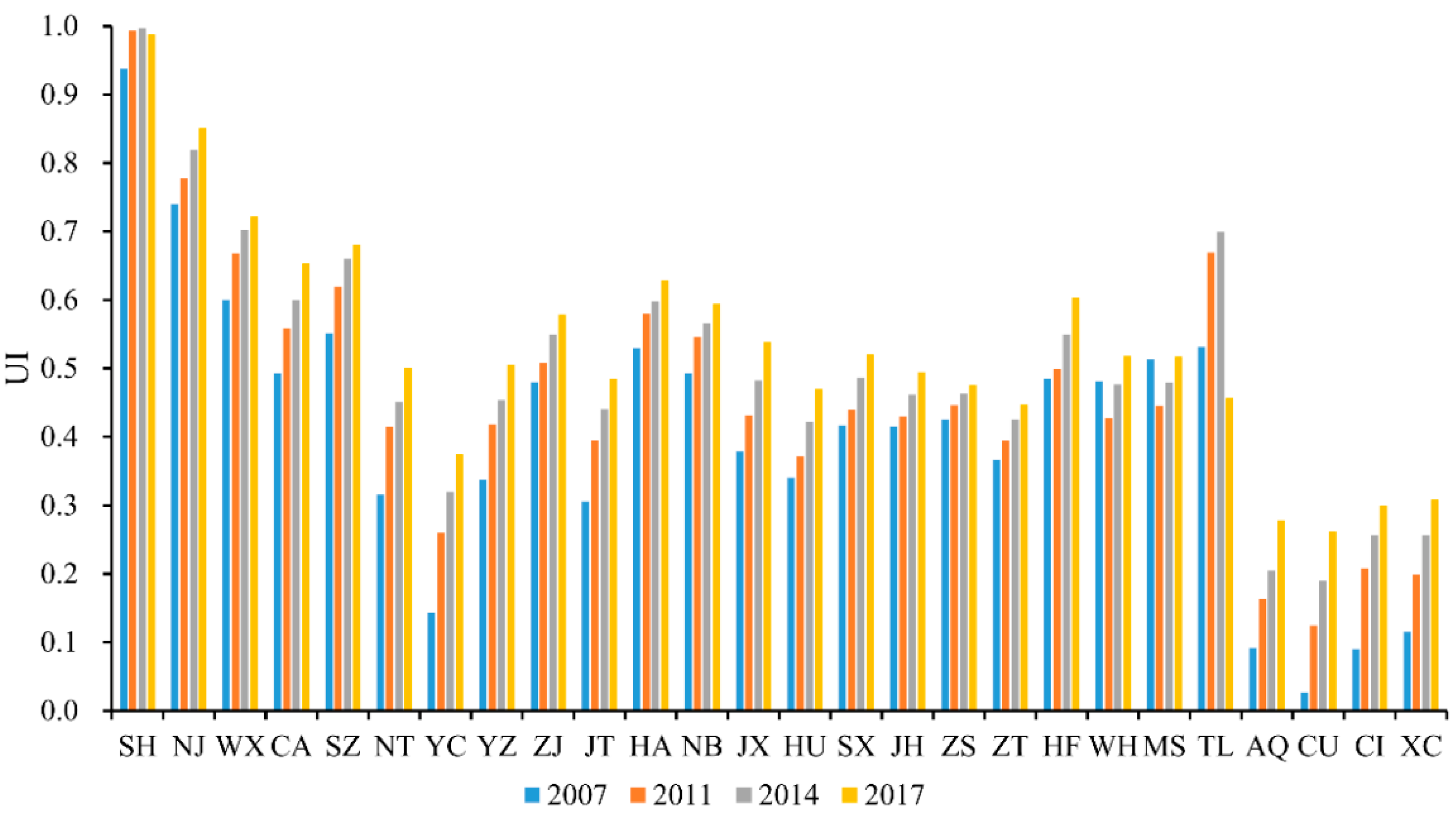
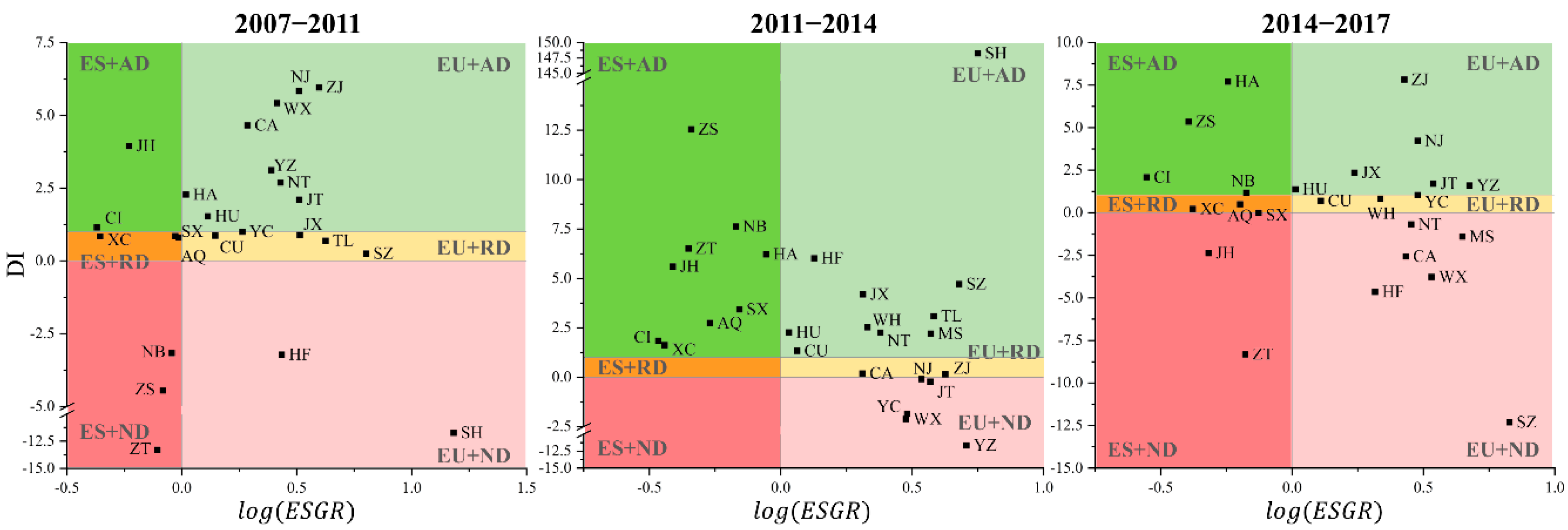

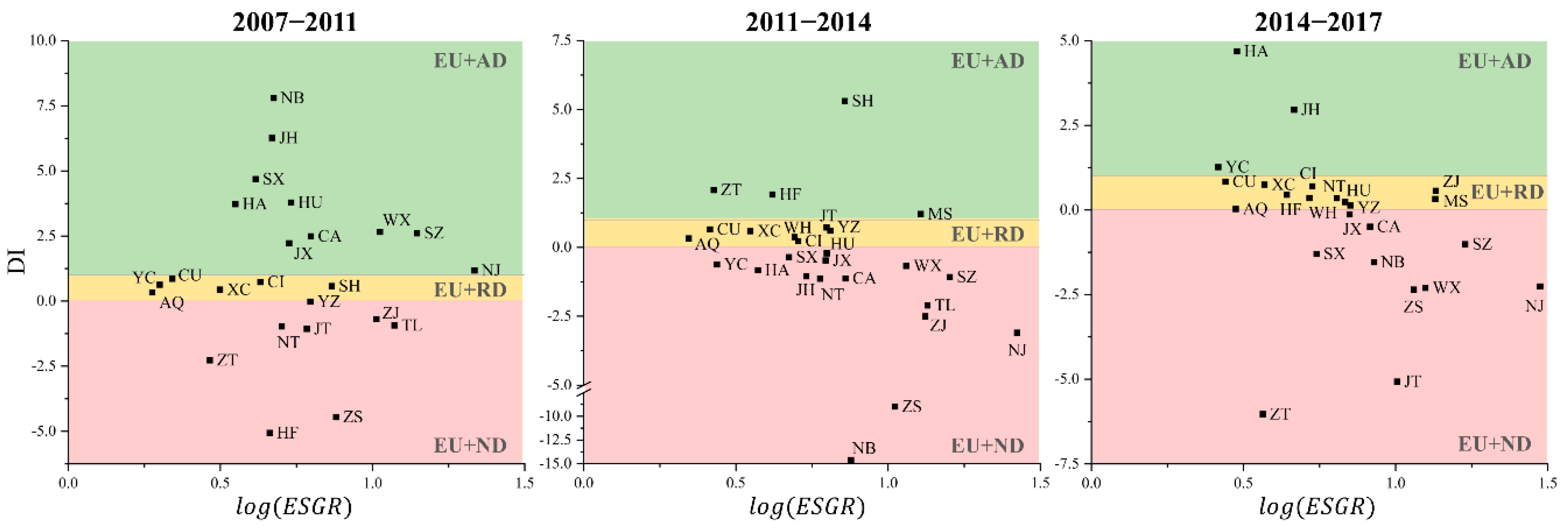

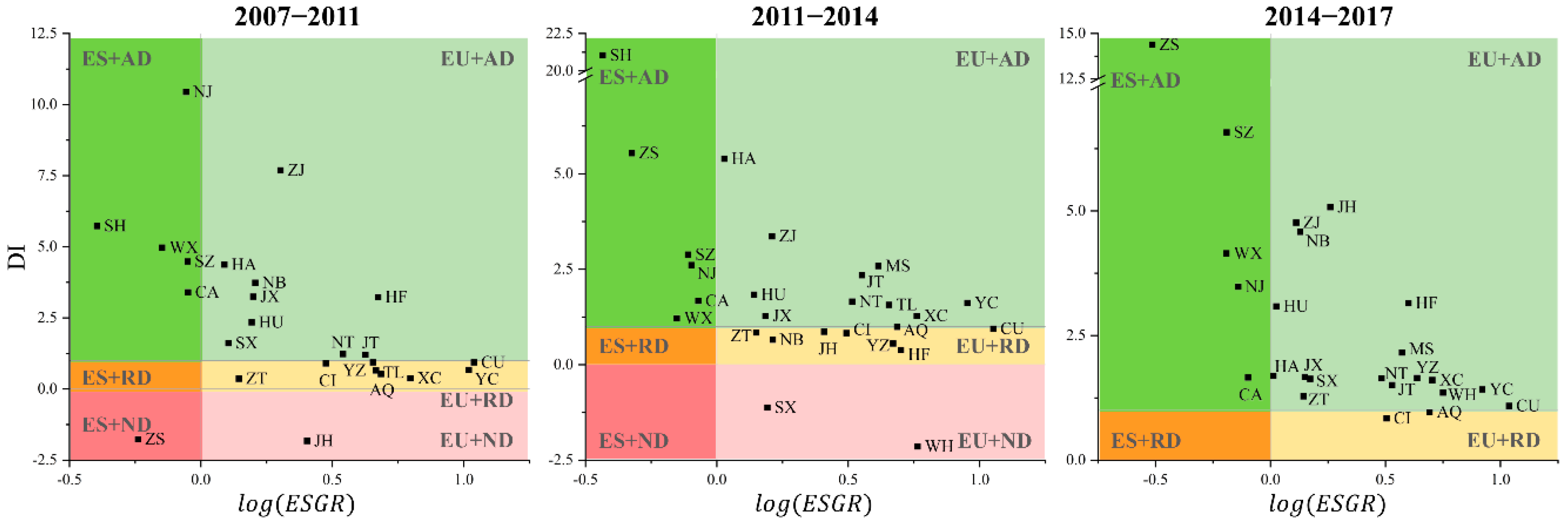


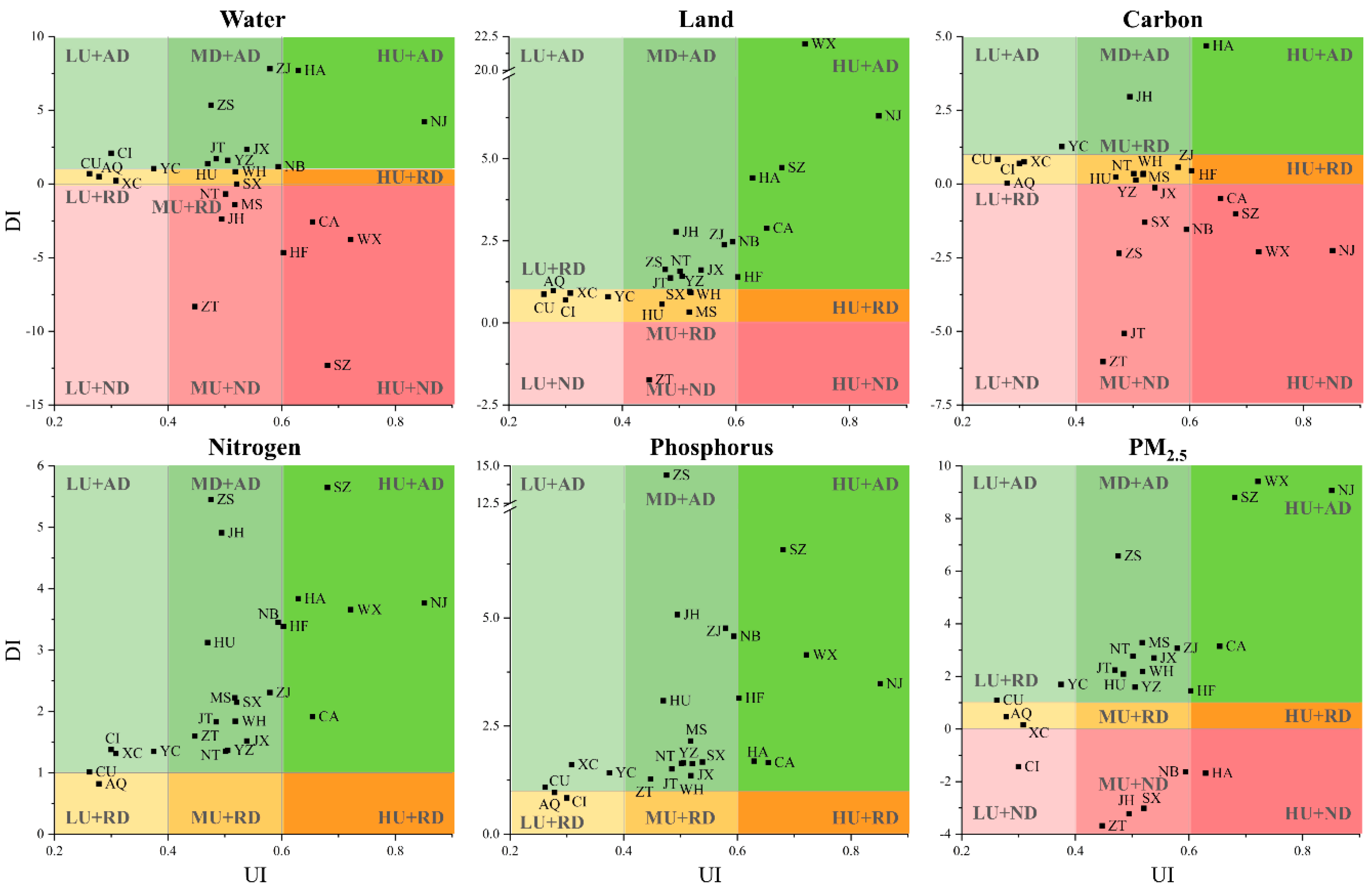
| City | Abbreviation | City | Abbreviation |
|---|---|---|---|
| Anqing | AQ | Shanghai | SH |
| Changzhou | CA | Shaoxing | SX |
| Chizhou | CI | Suzhou | SZ |
| Chuzhou | CU | Taizhou (in Jiangsu) | JT |
| Hangzhou | HA | Taizhou (in Zhejiang) | ZT |
| Hefei | HF | Tongling | TL |
| Huzhou | HU | Wuhu | WH |
| Jiaxing | JX | Wuxi | WX |
| Jinhua | JH | Xuancheng | XC |
| Maanshan | MS | Yancheng | YC |
| Nanjing | NJ | Yangzhou | YZ |
| Nantong | NT | Zhenjiang | ZJ |
| Ningbo | NB | Zhoushan | ZS |
| Variables | Data Sources |
|---|---|
| Annual PM2.5 concentration | NASA Socioeconomic Data and Applications Center [64], and the 26 cities’ ecological environment quality bulletins |
| Areas for cropland, grassland, forestland, water area and built-up area | The statistical yearbooks of Shanghai, Jiangsu Province, Zhejiang Province, Anhui Province and the 25 cities (2008–2018) |
| Energy consumption | |
| Nitrogenous, phosphatic and compound fertilizers | |
| Regional and urban population | |
| Regional land area and urban built-up area | |
| Regional GDP and value added of secondary and tertiary industries | |
| Yields for agricultural, animal, forest and aquatic products | |
| Equivalence factors for cropland, grassland, forestland, water area and built-up area | Liu and Li [65] |
| Global average yields for agricultural, animal, forest and aquatic products | Xie and Ye [66] |
| Nitrogen and phosphorus content of compound fertilizer | Kahrl et al. [67] and Wu et al. [68] |
| Per capita carbon, nitrogen and phosphorus planetary boundaries | O’Neill et al. [69] |
| Renewable water resources | The 26 cities’ water resources bulletins (2007–2017) |
| Water consumption | Shanghai, Jiangsu, Zhejiang and Anhui water resources bulletins (2007–2017) |
| Yield factors for cropland, grassland, forestland, water area and built-up area | Liu et al. [70] |
© 2020 by the authors. Licensee MDPI, Basel, Switzerland. This article is an open access article distributed under the terms and conditions of the Creative Commons Attribution (CC BY) license (http://creativecommons.org/licenses/by/4.0/).
Share and Cite
Huang, Y.; Zhang, J.; Wu, J. Integrating Sustainability Assessment into Decoupling Analysis: A Focus on the Yangtze River Delta Urban Agglomerations. Sustainability 2020, 12, 7872. https://doi.org/10.3390/su12197872
Huang Y, Zhang J, Wu J. Integrating Sustainability Assessment into Decoupling Analysis: A Focus on the Yangtze River Delta Urban Agglomerations. Sustainability. 2020; 12(19):7872. https://doi.org/10.3390/su12197872
Chicago/Turabian StyleHuang, Yijia, Jiaqi Zhang, and Jinqun Wu. 2020. "Integrating Sustainability Assessment into Decoupling Analysis: A Focus on the Yangtze River Delta Urban Agglomerations" Sustainability 12, no. 19: 7872. https://doi.org/10.3390/su12197872





